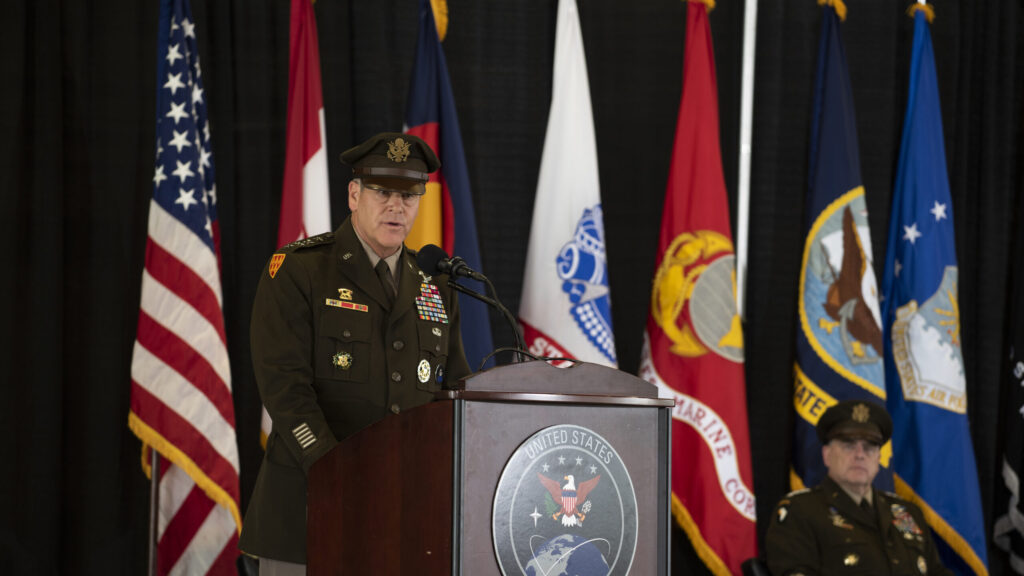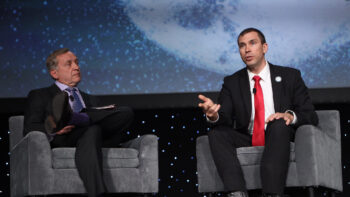
Gen. James Dickinson. (USSPACECOM Public Affairs, Lewis Carlyle)
Updated Nov. 29 at 6:10 pm ET to include a clarification of Gen. Dickinson’s remarks provided by a SPACECOM spokesperson.
WASHINGTON — US Space Command already is eyeing further streamlining once its just-announced reorganization settles into place, including a move to merge two of its operational centers, according to SPACECOM chief Gen. Jim Dickinson.
“Those are things that we’re looking at right now,” he told the Mitchell Institute in an online talk today.
SPACECOM on Nov. 15 announced it had created a new headquarters structure, called the Combined Joint Task Force-Space Operations (CJTF-SO), to oversee those two commands responsible for day-to-day operations: the Joint Task Force-Space Defense (JTF-SD) and the Combined Force Space Component Command (CFSCC).
The JTF-SD, headquartered at Schriever SFB, Colo., is responsible for protecting and defending US space assets, including those belonging to the Intelligence Community via the bilateral National Space Defense Center. The CFSCC, headquartered at Vandenberg SFB, Ca., takes care of space support functions for military operators, such as managing access to communications satellites and operating the GPS constellation. It is called a “combined force” command because it includes allied representatives.
The establishment of the CJTF-SO headquarters structure, Dickinson explained, was aimed at providing more “agility” and “flexibility” in decision-making than the old structure, which saw the leaders of both sub-commands reporting directly to him and SPACECOM headquarters staff.
The reorganization also means SPACECOM “will be able to synchronize both what we do from a space-enabling perspective as well as what we do for protect and defend on orbit,” and to avoid potential overlaps between those two inter-related missions, he said.
“And so the purpose of CJTF-SO, as most higher headquarters, will be the synchronization of those missions and synchronization of those resources,” Dickinson said.
As a first step, he said, the new CJTF-SO headquarters staff is working now to establish “its functions and roles and missions,” leading up to a SPACECOM declaration of initial operational capability (IOC).
But Dickinson suggested SPACECOM wanted to see if it could go further to streamline that decision-making structure, by looking at “whether or not we need two command centers, whether they could be one — I mean, those are all options that we’re looking at right now,” he added.
A SPACECOM spokesperson later in the day clarified that Dickinson was talking about two of the handful of operations centers that ultimately report up to him, rather than to overarching subordinate commands.
“Gen. Dickinson was referencing a number of options the command is considering to ensure efficiency and effectiveness. When asked directly about any potential further consolidation, his response was referring to two of the operational centers within the command, not the operational commands themselves, as one of many options,” the spokesperson said in an email to Breaking Defense.
Dickinson also praised the Space Force’s Nov. 23 standup of a new service component command at US Indo-Pacific Command headquarters in Hawaii.
“I believe that’s the right place at the right time for that element to stand up,” he said.
In response to questions about how the INDOPACOM Space Force component — and by implication future planned service components at other combatant commands — will work with SPACECOM’s own regionally embedded Joint Integrated Space Teams, Dickinson expressed no concerns about possible crossed wires.
The Space Force is a military service with the mission to organize, train and equip forces for operational combatant commands, of which SPACECOM is one. SPACECOM, which is both a geographical and a functional command, is responsible for ensuring other combatant commands are being provided necessary space capabilities to do their warfighting jobs, and that SPACECOM operators are responding to theater needs.
For example, Dickinson waived away the specter that the Space Force component might inject an additional layer of decision-making bureaucracy into the process for providing space capabilities to warfighters in the field.
“There won’t be an additional layer,” he said. The Space Force component’s creation “is actually enhancing the relationship, if you will, between INDOPACOM and US Space Command,” he said.
Dickinson explained that all the other services have component commands at INDOPACOM — just as they do at all six other geographic combatant commands — and that the Space Force’s component will work in the same traditional way.
“So, the INDOPACOM commander will look to that … space service component for all things space, if you will, in terms of support of his operations in his respective AOR [area of operations],” he said. “What will happen at that point will be the normal integration and coordination that would happen — that has happened [and] is happening right now — between that component and US Space Command in terms of making sure that we provide the space enabling capabilities that the INDOPACOM commander needs in support of his operations.”
The Guardians making up the service component command “work directly for the INDOPACOM commander, but there is a coordination relationship that already exists” with SPACECOM via the CFSCC, Dickinson added.
The CFSCC “executes tactical control over globally dispersed Air Force, Army, and Navy space [and now Space Force] units that command ground-based space capabilities and satellites in every orbital regime,” SPACECOM’s website explains.
In fact, Dickinson elaborated, Space Force created the new component by assigning to it Guardians already at INDOPACOM and familiar with the coordination process.
“So, that relationship already exists and will continue to exist,” he said, and “will mature.”
In a Taiwan conflict, tough choices could come for Big Tech
Washington could do more to incentivize tech companies to distance themselves from China, but CEOs should examine how they’d react to a fight in the Pacific, CSET’s Sam Bresnick and Emelia Probasco argue.



























